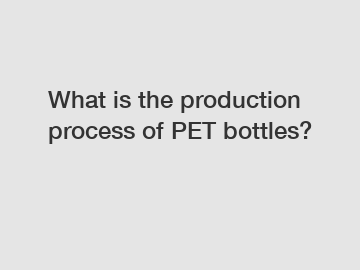What is the production process of PET bottles?
What is the production process of PET bottles?
PET (Polyethylene terephthalate) bottles are widely used in various industries, including packaging of beverages, food, personal care products, and even pharmaceuticals. Understanding the production process of PET bottles is crucial in order to appreciate the reasons behind their popularity, as well as to assess their environmental impact. In this article, we will delve into the details of the production process, explore the rationale behind each step, and discuss the significance and implications of using PET bottles.
The production process of PET bottles involves several key steps. Firstly, the raw material used is a polymer called PET resin. PET resin is derived from petroleum, specifically through the process of polymerization of terephthalic acid and ethylene glycol. The resulting PET resin is in the form of small granules or pellets.

The next step in the production process is the melting and extrusion of the PET resin. The resin pellets are heated and melted to form a molten state. This molten PET is then extruded through a die, which shapes it into a thin tube known as a parison. The extrusion process ensures uniformity in the thickness of the parison, which is essential for the structural integrity of the final PET bottle.
Once the parison is formed, it is transferred to the blow molding station. Here, high-pressure air is injected into the parison, expanding it against the walls of a mold. The mold imparts the desired shape and size to the PET bottle. After a cooling period, the mold is opened, and the newly-formed bottle is ejected.
Subsequently, the PET bottle undergoes trimming and finishing processes. Trimming involves removing excess material or flash, which may have formed during the blow molding process. Finishing processes include activities such as neck trimming, labeling, and the addition of handles or other accessories.
The production process of PET bottles holds immense significance due to several reasons. Firstly, PET bottles are lightweight, durable, and have excellent barrier properties. This makes them ideal for packaging applications, as they protect the contents from moisture, oxygen, and other external factors. Moreover, PET bottles are recyclable, which aligns with the growing focus on sustainability and reducing plastic waste.
The production process also influences the design and shape of PET bottles. Through blow molding, manufacturers can create bottles of various sizes, shapes, and thicknesses to meet specific consumer demands. This flexibility in design allows for the production of unique and eye-catching packaging, which can be a crucial factor in attracting customers.
In conclusion, the production process of PET bottles involves multiple stages, starting from the polymerization of PET resin to the final trimming and finishing steps. The meticulous attention to each stage ensures the production of high-quality bottles that meet the demands of various industries. The significance of this process lies in the suitability of PET bottles for packaging applications, their recyclability, and the design versatility they offer. As we aim to reduce plastic waste and promote sustainability, understanding the production process of PET bottles enables us to make informed choices and contribute to a greener future.
The company is the world’s best rPET pellets, rPET pellets, rPET pellets supplier. We are your one-stop shop for all needs. Our staff are highly-specialized and will help you find the product you need.

Comments
0